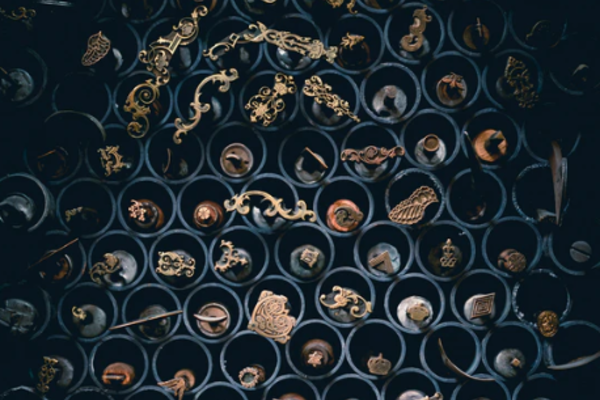Patchwork pictures, clutter, books, and improbable stories
I see myself as one of those drawers where you throw all the bits of paper and anything else you are not sure you want to throw away – letters, postcards, lists, bits of wrapping paper, cards, felt tip pens, stray buttons, special stones presented by a grandchild, a tiny piece of blue-patterned pottery found in the garden...
I remember a friend’s house many years ago – a rabbit warren of small cottage rooms – and the fireplace wall in the tiny sitting room was completely covered with postcards neatly stuck on the wall one next to the other, a patchwork wall. I was entranced and have always thought of doing something similar but never have. I have the pile of old postcards, places I’ve been and my favourite art. But over the years, the room I spend a lot of time in, does have various patchwork pictures on the walls. Straight across from where I sit is a large frame, about 4’ x 3’, filled with a mix of images – photographs, children’s drawings, my drawings, postcards and even a small newspaper article about bats. It was constructed in 1990 shortly after my father died as I wanted to put together some photographs about him and I had one large photograph that my son had developed of the road, lined with cypresses, to my father’s house in Italy. So I surrounded that photograph with a few photos of my father’s hillside house in Umbria, the hill town near where he lived, his gravestone in an old cemetery looking out over olive groves, a few pictures of him at various times, one from the late 1920s, one with my mother who had died 20 years earlier, a picture of his mother dressed in a traditional Russian costume, and a picture of his grandfather, with an enormous black beard and typical eastern hat, which he kept on his pinboard towards the end of his life.
I don’t know where he hid this photo over the years, but it was my mother’s troubled family that was more present in my life. Below this memorial to my father is another large photograph – an aerial photograph of the village I have lived in for many years and I surrounded it by other old pictures of the village plus photos of my children and in the centre a couple of their drawings. Other family photos surround the drawings along with favourite art – a page from the Lindisfarne Gospels, a Victorian sampler, Egon Schiele, Paul Klee, Edward Lear’s alphabet cat, an ancient Egyptian sculpture of a hippo relating to stories my brother used to make up about a tiny rubber hippo I had as a child. Higgledy-piggledy around these postcards are some Victorian family photographs I acquired later, my Russian great-grandparents, an uncle and aunt as small children in Kiev and my husband’s grandfather who we believe was the illegitimate son of a Victorian printmaker. Next to my large patchwork I have two small etchings by the printmaker, which were found in an attic addressed by the artist to my husband’s grandfather as a child.
There is another patchwork picture on the wall behind me – a patchwork of 25 photographs of derelict sheds, barns, doors and windows, some of my own and some from the internet. Near the centre is an old shed outside our house which we finally needed to have rebuilt, so this is a shed memorial. The photograph is of a cobweb and dirt-encrusted window with some shadowy old glass bottles behind. Other pictures are studies in rusted metal or rotting wood. Several come from researching my family history and the travels of a few of my ancestors across western America, one, a journalist, was part of a group of Russians setting up socialist utopian colonies in the early 1880s and later his son, drifting across America to the Pacific Northwest in the early 1900s after a traumatic childhood losing both his parents. As you move to the right in this picture, the subject changes more to windows, from a old warehouse I photographed in Huddersfield to a photograph of the shadows from Manhattan fire escapes to carved window surrounds in Siberia.
So what are these patchworks? Scraps of people’s lives? Things lost and sometimes found again, from abandoned buildings to bits of paper, old photos and postcards collected over a lifetime. I see myself as one of those drawers where you throw all the bits of paper and anything else you are not sure you want to throw away – letters, postcards, lists, bits of wrapping paper, cards, felt tip pens, stray buttons, special stones presented by a grandchild, a tiny piece of blue-patterned pottery found in the garden, paperclips, rubber bands, ideas for novels written on scraps of paper, a photograph you printed because you loved it but don’t know where to put it. Everything that doesn’t have a home. And maybe that is me, this mix of objects that do not have homes. There is an emotion about these displaced unwanted objects that draws me in. They say something to me like the derelict barns with rusty corrugated iron roofs that I love so much. I feel my home could be anywhere and I wonder if my ancestors felt the same. And so we only feel comfortable among these displaced objects.
But there is another part of me in this room – my bookshelves and the clatter in front of the books which make a three-dimensional patchwork of sorts. These are my books and objects of the 2000s as the room is a later extension to the back of the house, and as you move towards the front of the house the books go back through the decades to the 1960s. The clutter in front of the books is anything from a favourite tintoy bird to a delicately painted Russian doll, possibly from the 1920s, a papier-mâché puppet head I made years ago, and a tiny faded beany bear with a special expression. The books range from some I bought while I was doing my PhD in medical sociology, mostly memoirs, biographies and illness narratives of polio and disability. From my research I became more interested in uncomfortable silences and my family history and many of the books are Russian classics like Dostoevsky, Chekhov, Nabokov, Bulgakov, Isaac Babel, Vasily Grossman and recent novels about migration and exile. And memoirs that skirt around the Holocaust in atypical ways: for instance, The Five by Daniel Mendelssohn and In this dark house by Louise Kehoe. I will pick out one favourite book – Dora Bruder by Patrick Modiano. It’s a beautiful piece of detective work beginning with a real missing person’s ad the author finds in a 1941 Paris newspaper which describes a missing 15-year-old girl, Dora Bruder, and includes the names and address of her parents. This would be nothing out of the ordinary except this is occupied France, the family is Jewish and the Gestapo is searching for unregistered Jews. There would never be a good ending to this story.
When I first read Dora Bruder I was doing my own piece of detective work which had very uncomfortable possibilities. I had contacted a relation whose family were quite well-known Russian anarchists in early 1900s America and at one point he sent me a 1931 clipping from the New York Times asking if I knew the identity of the person in the article with their family name, which happened to be unique in the US records. The person in the article was the janitor of a luxury Manhattan apartment building and this family did not produce janitors – they were all well-educated social reformers or business people. I read the article and my stomach fell as I instantly realised who the person was, a cousin of my mother’s, the traumatised boy mentioned above. He must have wildly grabbed for a false name when questioned by the police, a family name he knew well as he had lived with them after his mother committed suicide in 1897 when he was 12. The article was about the double suicide of two chorus girls in their late 20s who had recently moved into a luxury Manhattan apartment building. According to the article the janitor had been alerted about a smell of gas when he arrived at work at 9am, had entered the apartment with his passkey, and had found the girls lying on a blanket on the kitchen floor with all the gas jets on. My cousin had probably stayed with his aunt and uncle for a couple of years and then became a sailor on the Black Sea and eventually found his way back to America and the Pacific Northwest, ending up in San Francisco working in luxury hotels and apartment buildings as night bellboy or janitor.
What had made my stomach lurch when I read the article was that he had privately published a few short stories in 1928, one of which was about a double suicide. In the story, two women who work together in a department store become friendly and the older woman persuades the younger one, whose husband has gambled their money away, to join her in committing suicide. The story is called the ‘Master Hypnotist’ and the hypnotist is the husband of the younger woman, a gambler who has learned to control people and situations through hypnotism, and when the two women are saved, the young wife realises she too can learn to control situations. My cousin was the gambling man who dabbled in hypnotism. Someone who met him described his speech as ‘easy, soft-voiced and most interesting’. I had a sinking feeling that having saved the two girls in his story, he now had a compulsion to use his knowledge of hypnotism to recreate the scenario of his imagined double suicide and save the young women, as he had not been able to save his mother because he had no passkey to get into the locked bathroom where his mother had turned on the gas. I have tried to step into the shoes of this very troubled man because I do identify with his need to be an outsider, only feeling comfortable observing others’ lives rather than joining them.
As I finished writing, I reached across to my computer screen and picked up a small, round object on the base. I had been clearing all the messy drawers in our house prior to moving house, back a few weeks ago before coronavirus halted life as we knew it, and this tiny object, about 2cm at its widest, was the kind of sculpture one of my children made when he was about five or six. This one seems to be a round blob of white glue which has several staples, a bit of tinfoil, and quite a few round circles of paper from a paper punch impressed into it. Maybe if someone asked me who I am or what makes me tick, I should answer simply that I am the kind of person who loves this little blob of glue with it staples, tinfoil and hole punch remnants.
In the time of coronavirus, Ruth Bridgens is an older vulnerable person with an underlying condition, but before that she has been an artist, done a partially autoethnographic PhD in medical sociology, is interested in narrative and memoir, and has done extensive research into the mysteries of her Russian family. She blogs here.















